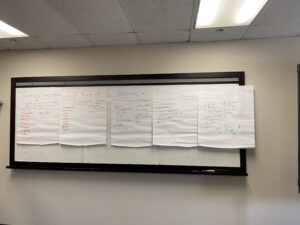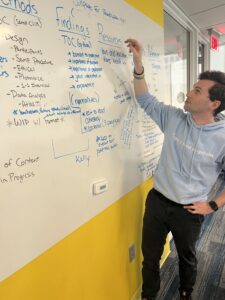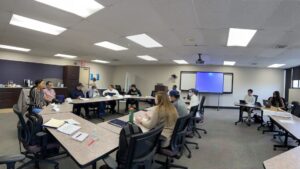 The members of the Disability Employment Project and Harc came together and brainstormed the best way to conduct our research. We found that the qualitative method of Photovoice for participants with disabilities and one-on-one interviews with businesses would be the best research techniques to collect data pertaining to our research questions and objectives. Photovoice as a methodology helped us understand individuals’ perspectives, and encourage our participants to be their own advocates to tell their own experiences and stories which in return can inform employees and policymakers. We used Trint, an AI-powered transcription service to transcribe, and Atlas.ti to code our focus group meetings and interviews. Additionally, we supplemented our active research with a literature review on disability studies and disability employment and secondary data collection about disability statistics.
The members of the Disability Employment Project and Harc came together and brainstormed the best way to conduct our research. We found that the qualitative method of Photovoice for participants with disabilities and one-on-one interviews with businesses would be the best research techniques to collect data pertaining to our research questions and objectives. Photovoice as a methodology helped us understand individuals’ perspectives, and encourage our participants to be their own advocates to tell their own experiences and stories which in return can inform employees and policymakers. We used Trint, an AI-powered transcription service to transcribe, and Atlas.ti to code our focus group meetings and interviews. Additionally, we supplemented our active research with a literature review on disability studies and disability employment and secondary data collection about disability statistics.
Table of Contents
1. Research Design
2. Data Analysis
3. Limitations
4. Validity and Reliability
Research Design
Photovoice
Photovoice is a participatory qualitative research method that expresses social issues through art and interpretation from the perspectives of individuals and communities. Photovoice gives individuals, mostly the marginalized and vulnerable populations whose voices are usually silenced, the opportunity to voice their own concerns and issues through the images they capture and their own narratives. Therefore, we can better understand their needs and interests. This methodology fits into our project because 1) it is important for us that we work in a participatory action research framework and 2) we want our participants also be the researchers throughout the project.
In total, we had three meetings with our participant researchers, residents of Harc with disabilities at their place in the Harc building. At the first meeting, our participant researchers received instructions regarding ethical considerations on photovoice and the initial introductory directions for the first photo assignment 10 days before the first discussion meeting. Each participant was required to sign a consent form. We also informed them that if they include other individuals in the pictures, they need to provide a signed consent form from them. Our participants received the research question at the first meeting and were asked to take 3-4 pictures answering it: “What is the importance of employment in your lives (as people with disabilities)?”
After the collection of photos we, student and participant researchers, then gathered two additional times in a focus group setting at Harc Inc. During the first focus group meeting, the photos were shown to the group to facilitate discussion to learn and understand their needs and interests around employment. After discussing what we learned in the first meeting as a group, we observed that there were leading themes that emerged from the first discussion such as “the meaning & importance of employment”, “barriers of employment”, and “importance of support” Therefore, we decided to delve more into these emerging themes along with our participants. Many different additional perspectives also emerged through discussion. These meetings were recorded and notes were taken during the meetings. Memos were also kept following the meetings. Additionally, we transcribed these recordings using Trint. The two discussion meetings lasted around an hour and a half followed by inner discussion within the group. Representatives of Harc were present at all meetings. When required, they assisted us with communication through discussions.

Sampling Procedure and Participants
Our Photovoice focus group meetings included seven Harc residents referred by Harc who are people with disabilities. While specific diagnoses are unknown, they are all individuals with intellectual or developmental disabilities. Some of these individuals were previously employed, some are currently employed, and some are actively looking for employment. We used pseudonyms to provide the confidentiality and anonymity of our participants.
Ethical Considerations
As student researchers, we did weeks of research about not only the employment experiences of people with disabilities but also their daily lives and other difficulties.
Student researchers along with our Principal Investigator were the only individuals with access to password-protected files and data. To further protect the identities of the participants in the study, we used pseudonyms when presenting our findings. However, we also acknowledged the fact that it is important for our participants to voice their own interests and concerns. Therefore, with their consent, we included their own statements and words in the posters (which can be used for reach-out purposes) we prepared.
Because our research project required us to research people with disabilities, these individuals fall under vulnerable persons, requiring full review by the IRB. To prepare for this, we made a legal guardian consent form for participants to get signed. These forms briefly outlined the Photovoice procedure, their rights to deny participation and disclosure of the use of recorders. To use the recorders in addition to having permission to take one’s photo, a media consent form was also included. They are ensured that there are no foreseeable harms or risks associated with participation.
One-On-One interviews
We attempted to reach out to multiple current and former employers that partnered with Harc. Unfortunately, none could be reached. We relied on our literature review and public statements to understand their perspectives.
Data Analysis

Photovoice as a methodology gave us the opportunity to analyze our data with our participants. After the initial analysis of our data, we gathered with participants and discussed emerging themes along with various codes that fell under them in the second meeting. Then, we continued analyzing our data through Atlas.ti which is a qualitative data analysis and measurement tool. This software program was used to code the Photovoice focus group transcripts produced by Trint. The purpose of Atlas.ti is to analyze large amounts of data. Our process consisted of making connections between the transcripts of the respective qualitative research methods and creating code to reach broader themes. Some of us also utilized Microsoft Word to code the data. Using these themes, we developed a cohesive narrative that can be found in our findings.
Data Coding
Data coding is the process of labeling qualitative data, like the transcriptions from our Photovoice focus group meetings, for the purpose of analysis. These labels provide us with information about how frequently each topic was mentioned, how commonly certain phrases appeared next to each other, and what specific participant researchers mentioned.
Coming into the focus group meetings, we brainstormed some themes we were going to utilize, informed by our literature review. In that sense, first, we approached our data seductively. Then we developed a shared codebook and did three separate coding “cycles.” To refine our process, we merged, deleted, or added codes as more material was analyzed in a more inductive way. These codes worked as specific examples under the broader theme.
Additionally, during our second meeting, we did an exercise with our participants where they identified keywords for our different themes. This active participation in our research — telling us what to code for, in a way — kept them in the loop and made our final narratives best reflect their experiences.
Limitations
To answer our research question we only took a small sample of individuals with disabilities. This sample was also drawn from one location, Harc Inc. in Hartford, Connecticut.
Initially, we were planning on interviewing businesses that work with Harc to employ their residents, as well as individuals working for state offices or non-profits. Due to a lack of time and a 0% response rate, we decided to forgo this data collection method.
During the Photovoice meetings, at least one of the supervisors was in the room while participants were answering questions. The presence and abundance of supervisors in the room while participants were giving answers could have affected how they answered the questions, especially pertaining to Harc. (We also acknowledge that staff was helpful in communication-related issues when required). Lastly, many participants mentioned how COVID-19 impacted their jobs. Some participants were fired due to the business’s financial instability, health risks, and then because of the rise of remote desktop work. This is an issue that we would like to research in the future: the effect of COVID-19 and the rise of remote work on the employment of people with disabilities.

Validity and Reliability
Validity in qualitative research means “appropriateness” of the tools, processes, and data. Creswell (2014) argues that validity in qualitative research is based on determining whether the findings are accurate from the standpoint of the researcher(s), the participant(s), or the readers, and associated concepts are trustworthiness, authenticity, and credibility. Photovoice in particular as a methodology provides a great advantage in providing this. With photovoice methodology, we got the opportunity for triangulation with different researchers (as a team of researchers including 6 of us and our 7 participants along with our project director) so we coded our data iteratively and collaboratively as a team of 14 different researchers. Our focus group meetings with our participants also provided the opportunity for member checking. We also had different data collection methods; focus group interviews and secondary data collection, as well as researching best case studies for inclusive employment. With different researchers and data collection methods, we got the opportunity to check for the accuracy of our findings.
Qualitative reliability indicates that the researcher’s approach is consistent across different researchers and projects (Creswell, 2014). Including our research design and interview protocols on our website, we are giving the opportunity to be tested over time.
The findings of our research study closely align with our background findings; Individuals with disabilities like working for reasons like having financial freedom, they like to help people, it keeps them motivated, and more. Individuals with disabilities face numerous barriers of employment including but not limited to discrimination, financial stability, and transportation. Individuals with disabilities persevered and stayed motivated to keep job searching because their positive experiences outweighed their negative experiences.